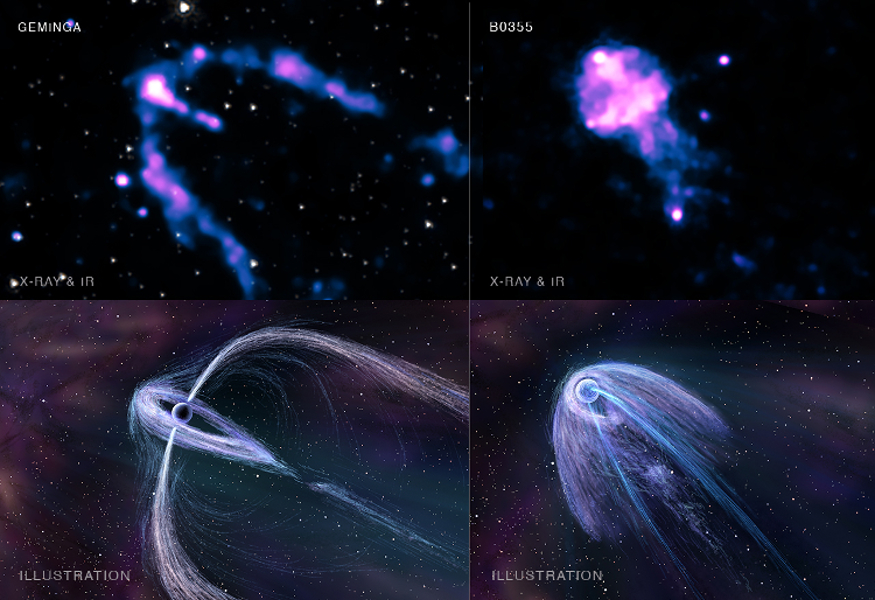
 Credit: X-ray: NASA/CXC/PSU/B.Posselt et al; Infrared: NASA/JPL-Caltech; Illustration: Nahks Tr'Ehnl
Credit: X-ray: NASA/CXC/PSU/B.Posselt et al; Infrared: NASA/JPL-Caltech; Illustration: Nahks Tr'Ehnl
Spinning in the Wind
Rapidly rotating magnetized neutron stars can produce pulses of radio, optical, X-ray or gamma-ray radiation. Radio and X-ray pulses are produced by narrow beams of particles near the magnetic poles of the neutron star which swing around through space as the neutron star spins. But neutron stars, produced by titanic supernova explosions, also fly through their host galaxies at supersonic speeds. As they fly through space, the wind of high-energy particles produced by the neutron star collides with the gas of the host galaxy, creating a bow shock similar to a sonic boom produced by the flight of a supersonic jet on earth. Using very deep observations with the Chandra X-ray Observatory, scientists have now resolved these shocks in two nearby pulsars, one called Geminga (a word which means "it's not there" in the Lombard dialect of Milan) and the other known more prosaically as B0355+54. The Chandra X-ray observations of the bow shocks around these two pulsars (as can be seen in the top row of the image above) seem quite distinct. Astronomers believe, however, that the resolved structures in both pulsar winds are very similar, but look different because of the orientation of the two pulsars to our lines of sight, as shown in the illustrations in the second row of the image above. In the case of Geminga, the spin and magnetic poles are nearly perpendicular to our line of sight, which produces huge arcs as the pulsar jets are swept back by the interstellar medium. For B0355+54, we look down along the pulsar jets, so that the extended arcs we see in Geminga are not visible to us, and the pulsar wind looks more compact, as an extended tail behind the pulsar. Geminga also shows a tail behind the pulsar, which may be evidence of a crushed torus near the equator of the pulsar, or perhaps represents high energy emission of the type seen in the magnetotail of earth.
Published: January 30, 2017
<
HEA Dictionary ● Archive
● Search HEAPOW
● Other Languages
● HEAPOW on Facebook
● Download all Images
● Education ● HEAD
>

Each week the HEASARC
brings you new, exciting and beautiful images from X-ray and Gamma ray
astronomy. Check back each week and be sure to check out the HEAPOW archive!
Page Author: Dr. Michael F. Corcoran
Last modified Monday, 26-Feb-2024 17:23:25 EST


